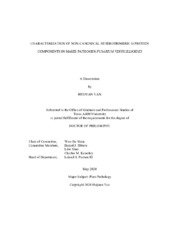| dc.description.abstract | Fusarium verticillioides is a fungal pathogen of maize causing ear rot and stalk rot diseases. Importantly, the fungus also produces carcinogenic mycotoxins, fumonisins, on infested maize. Unfortunately, we still lack a clear understanding of how the pathogen responds to host and environmental stimuli to trigger fumonisin B1 (FB1) biosynthesis. In this study, we hypothesized that G-protein coupled receptors (GPCRs), heterotrimeric G proteins and regulators of G protein signaling (RGS) proteins play important roles in sensing environmental cues and activate signaling pathways. Previously, we demonstrated that Gβ protein FvGbb1 directly impacts FB1 regulation but no other physiological aspects in F. verticillioides. In this study, we identified and characterized Receptor for Activated C Kinase 1 (RACK1) homolog FvGbb2 as a putative Gβ-like protein in F. verticillioides. The mutant exhibited severe defects not only in FB1 biosynthesis but also in vegetative growth and conidiation. FvGbb2 was positively associated with carbon source utilization and stress agents but negatively regulated general amino acid control. As for RGS proteins, F. verticillioides has two FvFlbA paralogs, namely FvFlbA1 and FvFlbA2, unlike yeast and Aspergillus species with a single copy of FlbA. Previously, we demonstrated that FlbA2 protein negatively impacts FB1 regulation in F. verticillioides. In this study, we further characterized the role and association of two FvFlbA paralogs. We learned that FvFlbA1 deletion did not lead to significant physiological defects, but FvflbA2/A1 double mutation resulted in severe growth defects and elevated FB1 production than those observed in single mutants. Taken together, our data suggest that heterotrimeric G proteins and RGS proteins perform unique functions in regulating F. verticillioides growth, virulence and FB1 biosynthesis by associating with different proteins and signaling pathways. Additionally, the characterization of a small GTPase FvSec4 showed critical functions in asexual development, pathogenicity, stress responses and mycotoxin biosynthesis. GFP-FvSec4 is localized to growing hyphal tips and raised the possibility that FvSec4 is involved in protein trafficking and endocytosis. | en |


